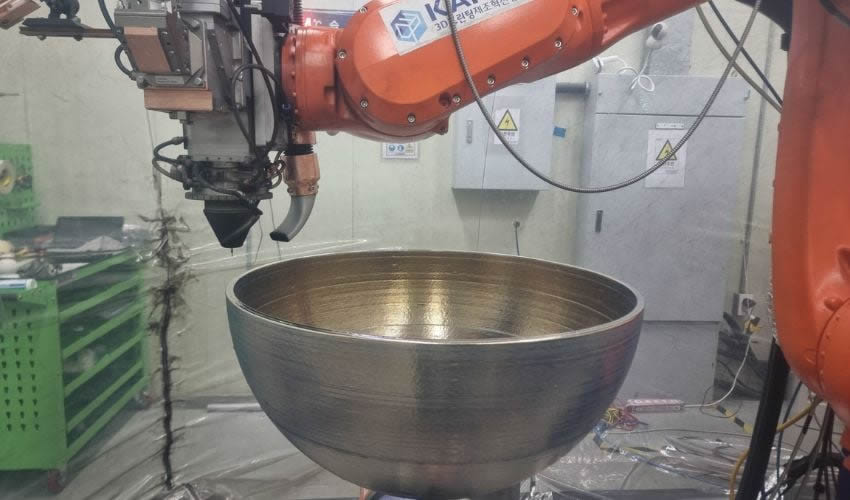Aerospace history took a step forward recently when a Korean research team successfully 3D-printed a titanium (Ti-6Al-4V) fuel tank that passed critical durability testing—withstanding 330 bar of pressure and cryogenic temperatures down to –196 °C—all without the need for protective coatings. For space-bound hardware, this is a significant leap forward. It’s also a reminder that in advanced manufacturing, the story behind a breakthrough often begins with the material supply chain.
Titanium Breakthroughs Are Supply Chain Stories
Ti-6Al-4V is a workhorse alloy in aerospace, known for its high strength-to-weight ratio, corrosion resistance, and performance in extreme environments. But it’s also an alloy that can be challenging to source in the right form, quantity, and quality for additive manufacturing. The production of aerospace-grade powder requires precision control over chemistry, particle size distribution, and flow characteristics—factors that directly impact build quality and consistency.

Image credit: KITCECH
For this fuel tank to meet its durability benchmarks, the team needed more than an innovative design and printing process. They needed titanium powder that could meet stringent aerospace standards—and they needed it on time. In additive manufacturing, powder quality and availability are as critical as the engineering itself.
Quality: Meeting the Demands of Space-Grade Printing
Space hardware operates in some of the harshest conditions imaginable, from the deep cold of liquid propellants to the punishing heat and vibration of launch. That means every layer of printed material must be free from contamination, within a tightly controlled size range, and consistent from batch to batch. Even small deviations in powder characteristics can compromise density, fatigue life, or thermal performance.

Image credit: 3D Natives
Producers who specialize in high-performance powders bring more than just raw material—they bring rigorous analytical testing, certification, and traceability. This ensures that engineers can move from design validation to production with confidence that their parts will perform exactly as intended.
For this fuel tank to meet its durability benchmarks, the team needed more than an innovative design and printing process. They needed titanium powder that could meet stringent aerospace standards—and they needed it on time. In additive manufacturing, powder quality and availability are as critical as the engineering itself.
Quality: Meeting the Demands of Space-Grade Printing
Space hardware operates in some of the harshest conditions imaginable, from the deep cold of liquid propellants to the punishing heat and vibration of launch. That means every layer of printed material must be free from contamination, within a tightly controlled size range, and consistent from batch to batch. Even small deviations in powder characteristics can compromise density, fatigue life, or thermal performance.
Producers who specialize in high-performance powders bring more than just raw material—they bring rigorous analytical testing, certification, and traceability. This ensures that engineers can move from design validation to production with confidence that their parts will perform exactly as intended.
Availability: Innovation Without Interruption
Innovation is often paced not by imagination, but by access to the right materials. In aerospace, production schedules can be tight and program delays costly. A single missed delivery of powder can ripple through a supply chain, delaying component manufacturing, integration, and ultimately launch schedules.
The titanium fuel tank project underscores the need for a ready-when-you-need-it supply model. This means having access to a reliable inventory of certified powder, produced domestically when possible, and delivered on schedule—so that groundbreaking designs don’t get stuck waiting for feedstock.
Resiliency: Building Stronger Supply Chains
While sustainability isn’t the lead story here, it plays a supporting role in supply chain stability. Domestic sourcing of titanium feedstock—especially through certified scrap-to-powder processes—can help insulate manufacturers from global raw-material volatility. By keeping production closer to the point of use, aerospace programs reduce transportation risks and gain more control over their timelines.
This localized approach not only supports environmental goals, but also strengthens resilience, ensuring that when critical missions arise, the necessary powders are in-hand and production can begin without delay.
The Path Forward
The success of this durability-qualified titanium fuel tank highlights what’s possible when advanced manufacturing meets ambitious design. But it also reinforces a less visible truth: material readiness is the foundation of innovation. Without reliable, high-performance powders available at the right time and in the right quantities, even the most promising projects can stall.
As aerospace and defense programs push the boundaries of additive manufacturing, powder producers must act as true partners—maintaining the highest standards of quality, ensuring availability, and adapting supply chains to meet evolving needs.
Breakthroughs like this one aren’t one-offs—they’re a preview of the next chapter in aerospace manufacturing. The right powder supply makes them repeatable.
If your next breakthrough depends on certified, high-performance metal powders delivered on time and to spec, our team can help you secure the supply you need—when you need it